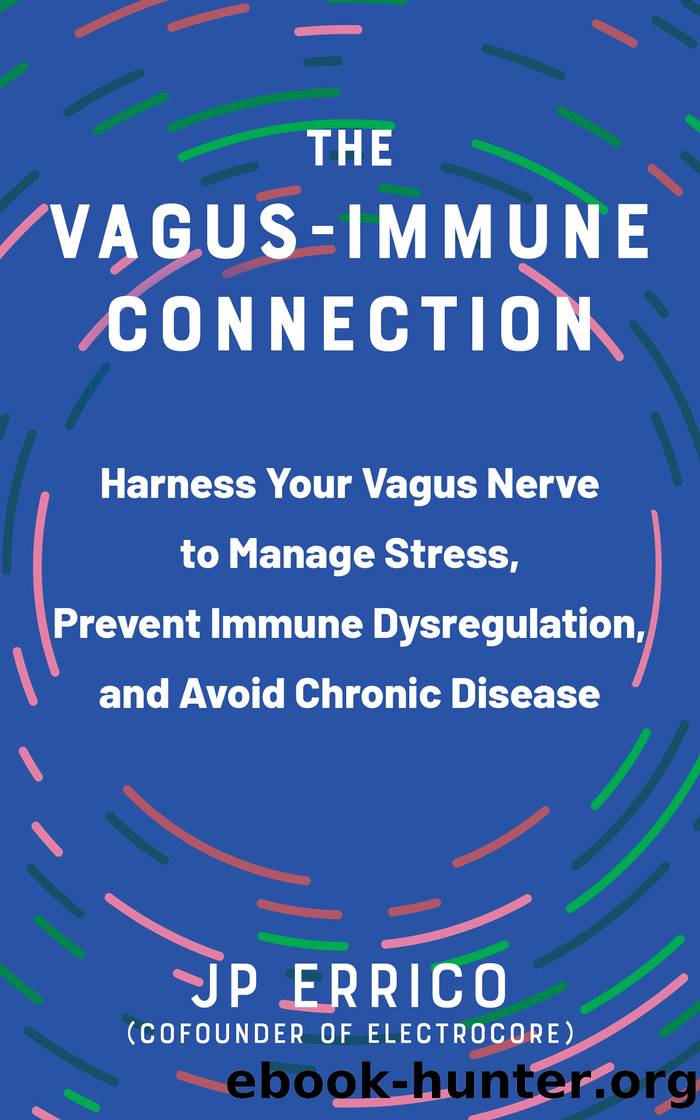The Vagus-Immune Connection by J.P. Errico & Dr. Habib Navaz

Author:J.P. Errico & Dr. Habib Navaz
Language: eng
Format: epub
Publisher: Ulysses Press
Published: 2024-03-12T00:00:00+00:00
POST-MENOPAUSAL RISKS
The uncomfortable symptoms of menopause, including fatigue, depression, hot flashes, and sleep troubles turn out to be far more than just an inconvenience, but rather are harbingers of future medical problems that can be far more serious. The timing and severity of these symptoms, called vasomotor symptoms, have been correlated with higher risks of several serious medical conditions during the post-menopausal period. Early and infrequent symptoms are associated with fewer complications, while late and frequent/severe vasomotor symptoms are associated with conditions, including cardiovascular disease, atherosclerosis, stroke, metabolic disease, osteoporosis, depression, and memory problems.156 Of course, all have been shown to be related to heightened sympathetic nervous system activity and inflammation. (The one of the above conditions that has not been previously covered is osteoporosis, which has been related to altered macrophage activity; in this case, the macrophages of bone, which are called osteoclasts.)
Bone formation in gestation, growth during childhood, and remodeling in response to stresses throughout life are all managed by the tissue-resident macrophages of the skeletal system, osteoclasts. These cells are most well-known for their ability to dismantle bone matrix, but it is their response to normal wear and tear that leads to the anti-inflammatory process that triggers the resorption of worn bone material that is not functioning and the promotion of their partner cells, the osteoblasts, to remodel and replace the bone that is not functional. This is reminiscent of the previously described macrophage function of efferocytosis (the noninflammatory debris clearance function used in adipose tissue turnover, blood vessel formation, neural development, and synaptic pruning).
In fact, the parallel between the remodeling of bone and blood vessel growth and remodeling is uncanny. In the development of a network of blood vessels, the macrophages coordinate the growth of a seemingly random connected tangle of vessels that is then sculpted back to an efficient network that maintains smooth blood flow with sufficient oxygen carrying capacity to handle the demands of the tissue it supplies. The initial deposition of bone matrix, for example in the case of a broken bone, is in the form of a thick callous, which is then optimized through a slow removal of bone matrix and mineralization that is superfluous. Just as aspects of autism spectrum disorder or Alzheimerâs disease can be considered a microgliosis (a disease caused by microglial dysfunction), and peripheral vascular disease can be observed to be a failure of the perivascular and vascular macrophages to maintain the micro vessel structures, osteoporosis can be considered a dysfunctional remodeling process by osteoclasts.
Not surprisingly, the peak of vasomotor symptoms, which includes hot flashes, coincides with the peak acceleration in bone loss. Long-term studies over the decade of menopause and post-menopause have found that women with moderate to severe vasomotor symptoms experienced greater demineralization (lower bone mineral density as measured in the spine and at the head of the femur) and increased rates of hip fractures compared with women who have minimal to no vasomotor symptoms. Again, during menopause, reduced hormone levels are linked to increases in
Download
This site does not store any files on its server. We only index and link to content provided by other sites. Please contact the content providers to delete copyright contents if any and email us, we'll remove relevant links or contents immediately.
Rewire Your Anxious Brain by Catherine M. Pittman(17635)
Talking to Strangers by Malcolm Gladwell(11981)
The Art of Thinking Clearly by Rolf Dobelli(8923)
Mindhunter: Inside the FBI's Elite Serial Crime Unit by John E. Douglas & Mark Olshaker(7894)
Becoming Supernatural by Dr. Joe Dispenza(7159)
Change Your Questions, Change Your Life by Marilee Adams(6702)
The Road Less Traveled by M. Scott Peck(6685)
Nudge - Improving Decisions about Health, Wealth, and Happiness by Thaler Sunstein(6684)
The Lost Art of Listening by Michael P. Nichols(6527)
Enlightenment Now: The Case for Reason, Science, Humanism, and Progress by Steven Pinker(6446)
Win Bigly by Scott Adams(6357)
Mastermind: How to Think Like Sherlock Holmes by Maria Konnikova(6294)
The Way of Zen by Alan W. Watts(5843)
Daring Greatly by Brene Brown(5693)
Big Magic: Creative Living Beyond Fear by Elizabeth Gilbert(4779)
Grit by Angela Duckworth(4776)
Men In Love by Nancy Friday(4381)
Flow by Mihaly Csikszentmihalyi(4094)
The Four Tendencies by Gretchen Rubin(4058)
